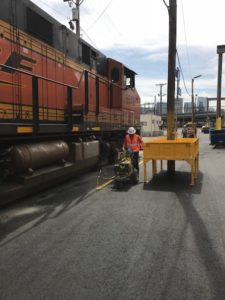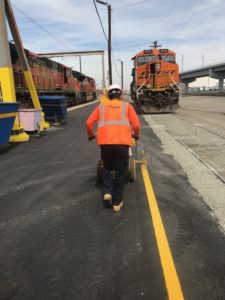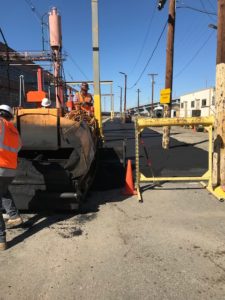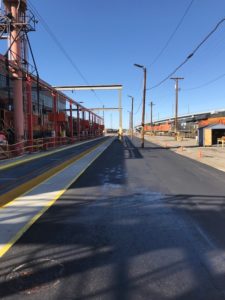Rose Paving’s Been Working on the Railroad

We can add now railroad paving to our service offerings
All aboard! Rose Paving recently completed an extensive railroad paving project for BNSF’s Globeville Rail Yard in Denver. This project represented many milestones for Rose Paving. Not only is the BNSF a coast-to-coast rail line, but the team had never worked for railway clients outside of private yards. Scroll down to see pictures and learn more about how our team buckled down and completed this challenging project.
About the Project
The Denver team was tasked with removing 10 inches of asphalt and base material to install 6 inches of stone and 4 inches of asphalt over 8,000 square feet. While the project’s scope of work may have seemed immense, the work taught the team valuable on-site skills. “Working in a live railyard brings a whole other element of challenges that you don’t have to deal with in a regular parking lot,” said Travis Hersh, Rose Paving Denver’s general manager.
Becoming Railroad Pavers
While paving seems straightforward enough, becoming a railroad paver is a whole different ball game. As far as material and workmanship, what railroad clients require goes above and beyond. Safety is front of mind, with federal regulations and strict best practices governing railyard operations. All crewmembers have to undergo background checks, two different certifications and two levels of testing.
According to Hersh, Rose Paving is now all clear to work with the rail system for the next few years.
Overcoming Challenges
It took a lot of testing and training just to step on the railyard, but the challenges were just beginning. Most paving teams, including ours, are used to being in control of their workstation, communicating with facilities managers to block off areas and schedule work around tenant hours. In the railyard, we were in someone else’s work territory, with live rails and trains bustling around us.
Not only did our pavers have to work far away from the live rails, but they also had to avoid numerous obstacles like telephone poles, live wires, manholes and low-overhead lines. The implications were huge: If we had hit a live wire, the line would have gone down from Kansas City to Denver. The height restrictions meant that we couldn’t tip trucks, so we employed special techniques to lay the asphalt safely and efficiently.
All of the obstacles were well worth it; the project was completed with a perfect safety track record. While it wasn’t what we saw every day, this challenging project in a new environment challenged our team to think creatively and reminded us how important it is to be continuing our education and constantly improving. Get the right pavers on your team and contact us today.








